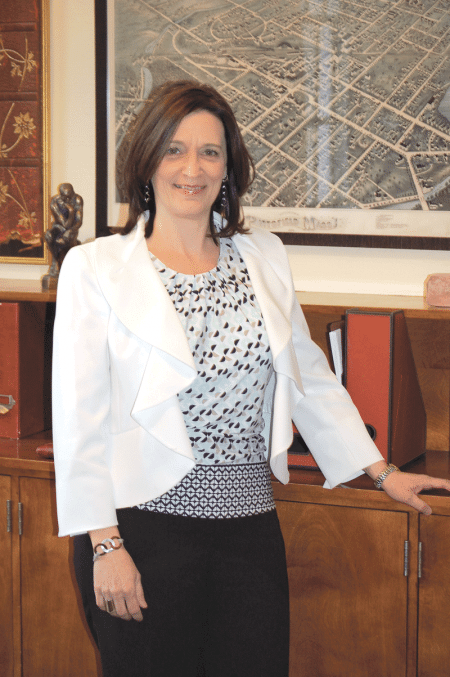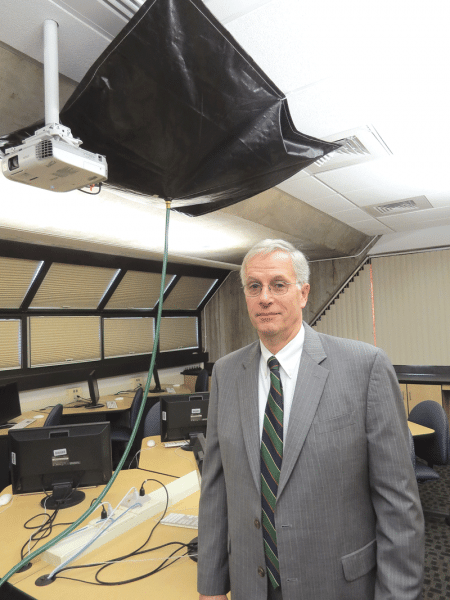Now Friendly Rivals
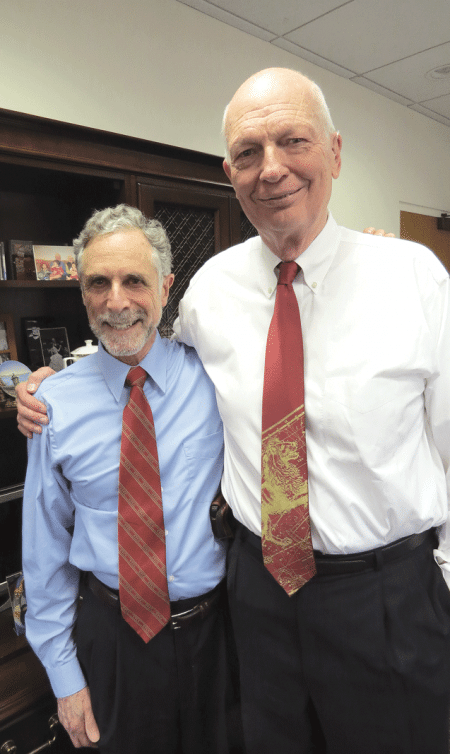
Bill Messner, right, and Ira Rubenzahl.
Located just seven miles apart as the crow flies, Holyoke Community College and Springfield Technical Community College have always competed, and in vigorous fashion, for everything from students to press coverage to state funding for capital projects. But when they arrived at their respective campuses in 2004, Presidents Bill Messner and Ira Rubenzahl found the relationship between the schools to be a case not of healthy competition, but unhealthy animosity. So they set about changing that equation. And as both men prepare to retire, they talked about what would have to be considered a stunning new attitude that prevails at both schools.
Neither man recalls which one of them actually picked up the phone and called the other.
What they clearly remember, though, is that a call, the first of many, was made. And, considering all that’s happened since the conversation ended, it could only be described with the adjective ‘historic.’
Ira Rubenzahl and Bill Messner had been at their new positions, as president of Springfield Technical Community College and Holyoke Community College, respectively, for just a few months (Rubenzahl arrived a few weeks earlier) in that summer of 2004. And while they hadn’t learned everything about the challenges that lay ahead, they did know one thing — that the relationship between the two schools, located just seven miles apart, had to change, and soon.
“Let’s just say that the institutions had not been working well together,” said Messner, his tone blending understatement with a dose of sarcasm as he described what he found upon his arrival. “And that was really not productive.”
Added Rubenzahl, “it didn’t take long to figure out that there was this problem. And we basically said, together, ‘we have to stop competing and start working together.’”
Actually, the competition hasn’t stopped, and both presidents agree that it can’t and won’t because, as the old saying goes, it’s good for the parties involved. But the animosity that prevailed a dozen years ago is mostly gone. And it hasn’t been missed.
For evidence of this, Rubenzahl and Messner pointed to a number of initiatives involving everything from workforce development to adult basic education; from legislative get-togethers to initiatives to train workers for MGM’s planned $900 million casino in Springfield’s South End.
They even listed the fact that the two travel together to meetings in Boston and elsewhere, and did so with a note of wonder in their tone that speaks volumes about just how bad things were.
Perhaps the very best piece of evidence, though, is the Deval Patrick Award for Workforce Development, presented by the Boston Foundation, which the schools earned together in 2014 for their collaborative effort known as TWO (Training & Workforce Options); more on that later.
Getting from where relations (if one could call them that) were in 2004 to where they are now didn’t happen overnight and would never be described as easy, both men noted.
“There are areas in which we’re much better off collaborating than we are competing,” said Messner. “But it took us a couple of years to get our arms around what those areas were, and how we could collaborate effectively.”
Also, the mountain to climb in terms of the level of animosity to be overcome was high and steep, said Rubenzahl.
“Bill and I got comfortable very quickly,” he noted. “But it took a while for the troops to line up because it was so inbred.”
Eventually, the troops did fall in line, both men noted, but the movement clearly started at the top.
Which is exactly why BusinessWest met with both presidents in Messner’s office in Frost Hall earlier this month. They’ve both announced that they’re retiring, with Rubenzahl due to exit stage left in June, and Messner a month or two later.
Yes, the presidents who arrived in the Pioneer Valley together will be leaving it together. And they’re leaving behind a track record of collaboration that couldn’t have been imagined a decade and a half ago.
Perhaps the best news is that both believe this pattern of cooperation has become so ingrained — and so welcomed by the schools’ respective boards — that they find it difficult to imagine a scenario in which it won’t continue after they’ve left their respective campuses.
“It will probably change in some ways to reflect the personalities of the two folks who are going to be following us,” said Messner. “But I think it’s grounded enough that it will continue. And my sense is that, if those two folks don’t choose to continue to collaborate, they’ll pay a price of some sort.”
New Course of Action
To put the dramatic change in the relationship between the two colleges in perspective, both Rubenzahl and Messner took a quick trip back to last summer and a press event that was significant on a number of levels.
Gov. Charlie Baker was coming to Western Mass. to deliver good news for both schools: HCC was getting $2.5 million for much-needed renovations of its cramped, antiquated, and leaky campus center, and STCC was getting $3 million for design work on a planned $50 million project to convert the historic structure known as Building 19 — one of the oldest buildings on the Springfield Armory complex later repurposed into the community college — into a new campus center.
He would announce both awards in a single ceremony at HCC, an arrangement STCC quickly signed off on.
“Before we came, they would never have dared to do that,” said Rubenzahl, saying those words slowly for additional emphasis and using the word ‘they’ to mean both the institutions and their presidents. “There would have been huge objections to doing that.”
Messner agreed, and, like his counterpart, treaded lightly, and diplomatically, when asked about the root causes of the sentiments that prevailed when he arrived.
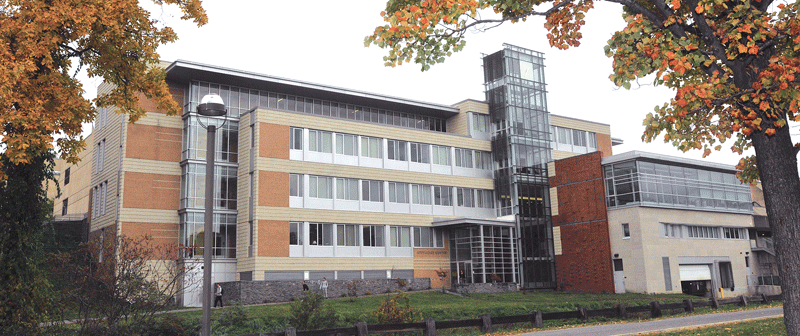
The opening of HCC’s Kittredge Center is one of the highlights of Bill Messner’s tenure, which was defined by improved relations with STCC.
However, it was well-known across the region, and even across the state, that the leaders’ predecessors — David Bartley, previously speaker of the Massachusetts House, at HCC, and Andy Scibelli, former Springfield city official and nephew of powerful state Rep. Anthony Scibelli, at STCC — didn’t exactly get along and were ferociously competitive, to put it mildly. And their institutions followed their lead — with a passion.
To explain the mood, Rubenzahl recalled some dialogue at a meeting he convened with several senior staff members at STCC not long after arriving.
“Someone referred to the ‘enemy,’” he recalled. “I said, ‘what enemy? Do you mean Holyoke?’ And he said, ‘yes, Holyoke.’ I was really taken aback by that, and said, ‘they’re not the enemy.’”
Rubenzahl believes that aforementioned phone conversation with Messner had already occurred by that point, but the chosen terminology cemented in his mind — actually both men’s minds, because similar language was being used in the campus off Homestead Avenue in Holyoke — that change was necessary.
And it came about, they said, partly due to those changes at the top, but also because it simply made sense.
Indeed, both presidents and their staffs had concluded that, while the schools would go on competing — “like Ford and Chevy do,” said Messner — they could also collaborate in many ways and, while doing so, achieve much more together than they ever could separately.
Examples abound, but TWO is clearly the most visible and perhaps the most impactful.
Messner described it as a “mechanism” for collaboration, the initiative that resulted from that somewhat time-consuming process he described earlier of determining in which realms the schools could collaborate, and how.
As the name suggests, the program involves creation of individually tailored programs to help solve workforce problems, specifically those related to the skills gap that has impacted virtually every sector of the economy.
Since its creation five years ago, TWO has assisted large corporations, small businesses, and broad economic sectors, said Rubenzahl, and it’s an example of something the schools could do with some success independent of one another, but to a much greater level of achievement together.
School of Thought
While TWO is the most visible manifestation of the new climate of cooperation between the two schools, there are many others, said the two presidents — starting with the meeting they were at just before sitting down with BusinessWest.
This was a gathering of state legislators to discuss matters involving public higher education, especially funding for the schools and individual initiatives. Years ago, there would have been two of these sessions, said Rubenzahl, one for HCC and one for STCC, because, well, that’s how it was done. (Actually, Greenfield Community College and Berkshire Community College had their own sessions as well.)
Now, there’s a single gathering — a practice that began the spring after the two presidents arrived — and it involves not only those two schools, but all seven public colleges and universities in Western Mass. Thus, the sessions are usually more productive because there are more people in the room, and far more convenient for legislators.
“I called Bill and said, ‘doesn’t it make sense to just have one?’” Rubenzahl recalled. “And for a lot of reasons; you’re more likely to get more legislators, and you can be more effective if you have several colleges saying the same thing as opposed to each one stating their individual needs.”
The legislative get-together is a simple yet effective example of collaboration, said Messner, adding that many others share its basic reason for being: common sense.
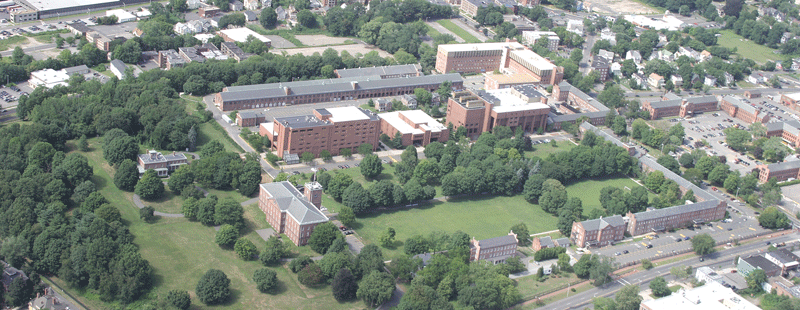
STCC President Ira Rubenzahl says his campus now looks for ways to collaborate with its competitor in Holyoke.
That list includes everything from faculty-development programs to the joint hiring of a consultant to create so-called wage grids; from adult basic education — something STCC has become more proficient at thanks to assistance from HCC — to the somewhat daunting task of training hundreds, and perhaps thousands, of the individuals MGM will eventually hire.
When looking back at how the current partnership on casino training came about, both presidents said this is another example of something that wouldn’t have materialized 13 years ago because of the animosity between the schools.
“We have this trust … we have this agreement — we don’t do things separately,” said Rubenzahl, adding that, years ago, the two schools probably would have fought tooth and nail for the entire pie. In this new era of cooperation, they agreed to split the pie long before the Gaming Commission determined the winner of the Western Mass. license.
“It wasn’t clear where the casino was going. Was it going to go to Palmer? Was it going to Springfield? Was it going to go to Holyoke?” he recalled. “But before we knew where it was going, we said, ‘an individual campus is not going to get involved in the training; we’re going to do it together.
“It winds up going in Springfield, but instead of fighting over it, we had already lined up our ducks,” he went on. “We had already figured out that, because Holyoke is really strong in culinary arts, if there’s culinary training, they’re going to get it. They can do it; we can’t do it. And we’re going to do some of the IT training, perhaps.”
Whenever there’s a meeting with MGM officials, the schools go together, said Messner, adding that the casino project is a good example of how the schools work together to meet the workforce needs of the five major sectors of the economy — manufacturing, healthcare, technology, hospitality, and financial services — because neither school can do all that alone.
As still another example of something happening now that wouldn’t have happened years ago — this one involving geography, or territory, as much as anything else — Messner cited initiatives blueprinted by Holyoke schools’ receiver Stephen Zrike for Dean Technical High School.
“He wants two programs connected to college work,” Messner explained. “One is going to be in healthcare, and we’ll do that one, and the other is manufacturing, and we’re going to do that in conjunction with STCC; we’re not going to try to do that alone.”
Added Rubenzahl, “because of this [new relationship], we can do things we couldn’t do otherwise. Before, you couldn’t do that — you couldn’t go into the other college’s hometown and run a public-school program.”
Class Act
As for those shared rides to Boston and other destinations for gatherings of public-school leaders, both men laughed as they talked about how the practice has evolved and how it never would have happened with their predecessors.
“I drive, and he talks,” said Messner, referring to how a typical journey unfolds.
But while they carpool to such meetings, they usually don’t sit together once they arrive — a tradition that is more strategic than any kind of statement about how the schools, and presidents, get along.
“We don’t want to look like a two-headed monster,” said Rubenzahl, adding that the two are usually of a similar mind on most matters and don’t want to appear to be delivering comments in stereo.
Messner agreed. “You can’t cluster your strength all in one part of the room — you have to spread it out.”
In truth, and despite those seating arrangements, the schools have indeed become a two-headed monster — of collaboration.
George O’Brien can be reached at [email protected]








